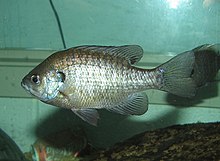Bluegill
| Bluegill | |
|---|---|
 |
|
| Scientific classification | |
| Kingdom: | Animalia |
| Phylum: | Chordata |
| Class: | Actinopterygii |
| Order: | Perciformes |
| Family: | Centrarchidae |
| Genus: | Lepomis |
| Species: | L. macrochirus |
| Binomial name | |
|
Lepomis macrochirus Rafinesque, 1810 |
|
The bluegill (Lepomis macrochirus) is a species of freshwater fish sometimes referred to as bream, brim, or copper nose. It is a member of the sunfish family Centrarchidae of the order Perciformes. It is native to North America and lives in streams, rivers, lakes, and ponds. It is commonly found east of the Rockies. It usually hides around, and inside, old tree stumps and other underwater structures. It can live in either deep or very shallow water, and will often move back and forth, depending on the time of day or season. Bluegills also like to find shelter among water plants and in the shade of trees along banks.
Bluegills can grow up to 12 inches (30 cm) long and about 4 1⁄2 pounds. They have very distinctive coloring, with deep blue and purple on the face and gill cover, dark olive-colored bands down the side, and a fiery orange to yellow belly. The fish are omnivores and will eat anything they can fit in their mouth. They mostly feed on small aquatic insects and fish. The fish play a key role in the food chain, and are prey for muskies, walleye, trout, bass, herons, kingfishers, snapping turtles, and otters.
The bluegill is the state fish of Illinois.
The bluegill is noted for the black spot that it has on the posterior edge of the gills and base of the dorsal fin. The sides of its head and chin are a dark shade of blue. It usually contains 5–9 vertical bars on the sides of its body, but these stripes are not always distinct. It has a yellowish breast and abdomen, with the breast of the breeding male being a bright orange. The bluegill has three anal spines, ten to 12 anal fin rays, six to 13 dorsal fin spines, 11 to 12 dorsal rays, and 12 to 13 pectoral rays. They are characterized by their deep, flattened bodies. They have a terminal mouth, ctenoid scales, and a lateral line that is arched upward anteriorly. The bluegill typically ranges in size from about four to 12 inches, and reaches a maximum size just over 16 inches. The largest bluegill ever caught was four pounds, 12 ounces in 1950.
...
Wikipedia

